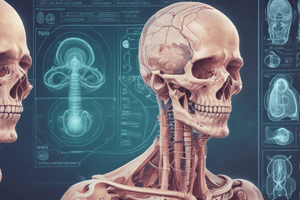Podcast
Questions and Answers
What is the term used to describe an imaging finding that does not directly correspond to the reality of the patient?
What is the term used to describe an imaging finding that does not directly correspond to the reality of the patient?
- Radiodensity
- Radiolucent
- Interface
- Artifact (correct)
What is the initial imaging study of choice for a 65-year-old male presenting with shortness of breath and chest pain?
What is the initial imaging study of choice for a 65-year-old male presenting with shortness of breath and chest pain?
- CT of chest
- Chest Radiograph (correct)
- MRI of chest
- Nuclear medicine V/Q scan
What type of imaging modality uses ionizing radiation to produce an image?
What type of imaging modality uses ionizing radiation to produce an image?
- Radiography (correct)
- MRI
- Ultrasonography
- PET
What is the term used to describe the border between two different radiodensities?
What is the term used to describe the border between two different radiodensities?
What is the modality of choice for a patient with blunt trauma to the chest after a high-speed MVA?
What is the modality of choice for a patient with blunt trauma to the chest after a high-speed MVA?
What is the term used to describe structures that block x-rays and appear white on a radiograph?
What is the term used to describe structures that block x-rays and appear white on a radiograph?
What is the main purpose of Radiography?
What is the main purpose of Radiography?
Who discovered x-rays in 1895?
Who discovered x-rays in 1895?
What is image contrast in Radiography?
What is image contrast in Radiography?
What is the term used to describe medical images that are the “shadows” projected onto a flat plane when x-rays pass through a patient?
What is the term used to describe medical images that are the “shadows” projected onto a flat plane when x-rays pass through a patient?
What is the primary indication for ordering a CT scan of the chest?
What is the primary indication for ordering a CT scan of the chest?
What is the preferred clinical indication for selecting MRI of the chest?
What is the preferred clinical indication for selecting MRI of the chest?
What is the term used to describe structures that allow x-rays to pass through and appear gray to black on a radiograph?
What is the term used to describe structures that allow x-rays to pass through and appear gray to black on a radiograph?
What is the term used to describe the categories of imaging modalities?
What is the term used to describe the categories of imaging modalities?
What is the primary advantage of Ultrasound over other imaging modalities?
What is the primary advantage of Ultrasound over other imaging modalities?
Which of the following imaging modalities is typically used to evaluate metabolic activity?
Which of the following imaging modalities is typically used to evaluate metabolic activity?
What is the characteristic of the flow in a carotid artery with a build-up of fatty deposits?
What is the characteristic of the flow in a carotid artery with a build-up of fatty deposits?
Which of the following is NOT a clinical indication for Doppler sonography?
Which of the following is NOT a clinical indication for Doppler sonography?
What is the primary advantage of using ultrasound in gynecologic exams?
What is the primary advantage of using ultrasound in gynecologic exams?
What is the purpose of using Doppler effects in ultrasound?
What is the purpose of using Doppler effects in ultrasound?
What is the term for the ultrasound examination used to evaluate the torso for free fluid in cases of trauma?
What is the term for the ultrasound examination used to evaluate the torso for free fluid in cases of trauma?
What is the name of the type of ultrasound used to detect wall motion abnormalities in the heart?
What is the name of the type of ultrasound used to detect wall motion abnormalities in the heart?
What is a limitation of ultrasound in obese patients?
What is a limitation of ultrasound in obese patients?
What is the primary route of excretion for intravascular iodinated contrast material in patients with normal renal function?
What is the primary route of excretion for intravascular iodinated contrast material in patients with normal renal function?
What is the typical duration of contrast agent elimination in dialysis patients?
What is the typical duration of contrast agent elimination in dialysis patients?
What type of reaction can occur in response to contrast agent administration?
What type of reaction can occur in response to contrast agent administration?
What is the primary purpose of administering contrast agents in imaging?
What is the primary purpose of administering contrast agents in imaging?
What type of MRI contrast agents can delineate vessels as well as parenchymal tissues?
What type of MRI contrast agents can delineate vessels as well as parenchymal tissues?
What is a benefit of using ultrasound in medical imaging?
What is a benefit of using ultrasound in medical imaging?
What is a common precaution taken in patients with a history of contrast allergy?
What is a common precaution taken in patients with a history of contrast allergy?
What type of signal is produced by cartilage and muscle?
What type of signal is produced by cartilage and muscle?
What is the typical feature of cysts and homogeneous solid masses, such as lymphomas?
What is the typical feature of cysts and homogeneous solid masses, such as lymphomas?
What does color Doppler display?
What does color Doppler display?
What is plotted on the vertical scale (y-axis) in Doppler spectral display?
What is plotted on the vertical scale (y-axis) in Doppler spectral display?
What is the significance of brighter colors in color Doppler?
What is the significance of brighter colors in color Doppler?
What is the direction of flow represented by the color above the black bar in color Doppler?
What is the direction of flow represented by the color above the black bar in color Doppler?
What is the purpose of Doppler sonography?
What is the purpose of Doppler sonography?
What is the typical feature of acoustic enhancement?
What is the typical feature of acoustic enhancement?
Flashcards are hidden until you start studying
Study Notes
Radiography
- Radiography is a type of medical imaging that uses x-rays to produce images.
- It is also known as x-ray, plain film, radiograph, and conventional radiograph.
- Radiography was discovered by Roentgen in 1895.
- Radiography refers to the medical images that are the "shadows" projected onto a flat plane (planar) when x-rays pass through a patient.
Image Contrast
- Image contrast is the difference in brightness between an area of interest and its surroundings.
- The larger the difference in brightness between different tissue types, the easier it is to differentiate them from each other.
Artifacts and Interfaces
- An artifact is an imaging finding that does not directly correspond to the reality of the patient.
- Artifacts may mimic a clinical feature, degrade image quality, or obscure anatomy.
- Radiological interfaces are between different radiodensities, such as the border of the heart against the lung.
Planar vs Cross-Sectional Imaging
- Planar images are shadows of complex three-dimensional objects, e.g. radiography.
- Cross-sectional images show the three-dimensional reality of anatomy, e.g. CT, ultrasound, and MRI.
Categories of Medical Imaging
- Radiating imaging modalities: use ionizing radiation to produce an image, e.g. radiography, CT, nuclear medicine.
- Non-radiating imaging modalities: do not use ionizing radiation to produce an image, e.g. MRI, ultrasound.
Five Basic Densities Seen on Conventional Radiography
- Radiopaque: denser structures block x-rays better, appear white on radiograph.
- Radiolucent: less dense structures allow x-rays to pass through, appear gray to black on radiograph.
- Cartilage and muscle: produce a hypoechoic signal, appear dark as most waves pass through the tissue.
- Fluid and fluid-filled structures: produce an anechoic signal, appear black as there is no reflection of ultrasound waves.
Ultrasound
- Ultrasound uses high-frequency sound waves to produce images.
- It is also known as sonography.
- Doppler sonography provides valuable information regarding the presence, direction, and velocity of blood flow.
- Clinical indications for ultrasound include gynecologic exams, echocardiography, abdominal exams, and procedures.
Strengths and Weaknesses of Ultrasound
- Strengths: lack of ionizing radiation, low cost, portability, lack of use of contrast.
- Weaknesses: cannot penetrate gas or bone, obese patients may be difficult to penetrate, dependent on the skills of the operator scanning.
Contrast Agents
- Contrast agents are used to distinguish adjacent tissues in imaging by creating a temporary, artificial density difference between objects.
- Contrast agents can be used in radiography and CT.
- Iodinated contrast material is excreted through the renal system.
- Contrast reactions can be anaphylactoid or chemotoxic reactions.
Magnetic Resonance Contrast Agents
- The two classes of MRI contrast agents are diffusion and non-diffusion agents.
- Diffusion agents can delineate vessels as well as parenchymal tissues.
- Non-diffusion agents remain in the bloodstream and are primarily useful for MRA.
Studying That Suits You
Use AI to generate personalized quizzes and flashcards to suit your learning preferences.





